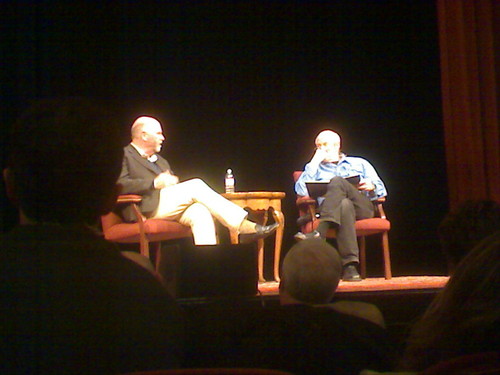Craig Venter @ The Long Now
Posted on Wednesday, February 27, 2008
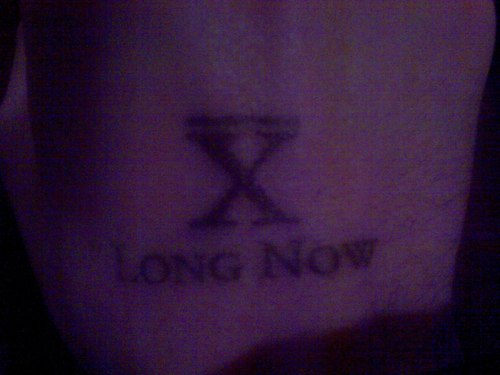
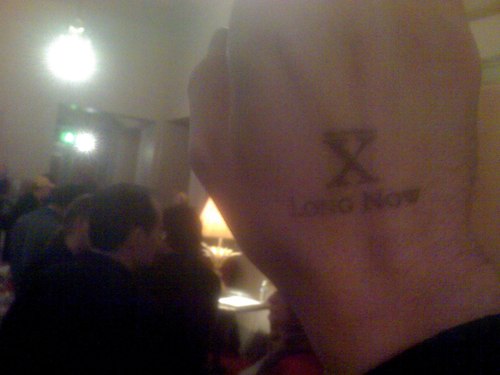
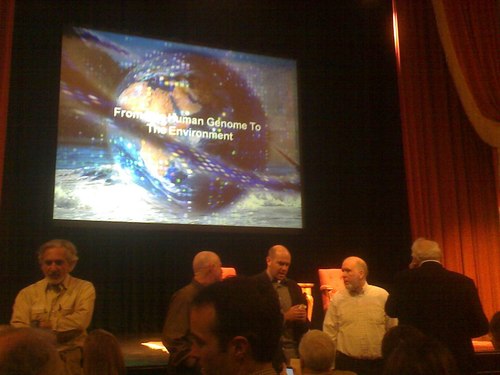
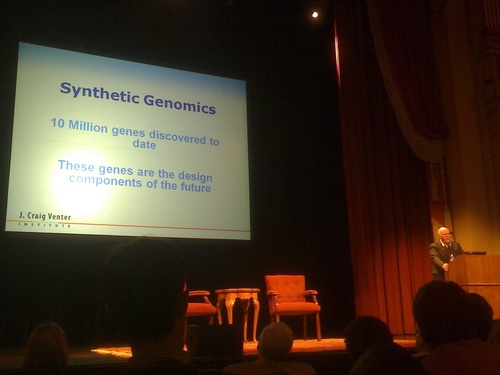
After watching online seminars for over a year now, yesterday I finally got a chance to visit a Long Now seminar in person down in San Francisco. And guess what..!? I was on their guest list ;-) Ever since I learned about The Long Now Foundation over a year ago, I've been a fan. So when I was offered a chance to become a charter member last year, I didn't hesitate. Even got me one of those metal plates the size of a credit card. Plus my name on their guestlist. #518 I am.
So here I was, first choice in seating, amongst all those people I've been learning about by reading a wide variety of blogs over the years: Kevin Kelly, Peter Schwartz, John Brockman, Stewart Brand, Chris Anderson etc. Having arrived in the US only a few days ago, I was clever enough to take my camera battery charger with me while jumping in my car here in Mountain View to head over to SF, only forgetting to realise it only has a European plug. With the battery depleted before arrival in San Francisco (driving the 101 makes for perfect filming scenery ;-), I was left with only my Sony Ericsson P990i phone camera to make some snapshots of the lecture and the audience. Overall, Craig Venter was pretty straightforward in his view on the coming age of biotech. Or, as Stewart Brand put it in his short summary emailed around after the event:
To really read DNA accurately and understand it thoroughly, you need to be able to write it from scratch and make it live, Venter explained.
His sequencing the first diploid human genome (with the genes from both parents) last year showed there is much more genetic variation between humans than first thought. His current goal is to fully sequence 10,000 humans and bring the price for each sequence down to $1,000. With that data, his says, "We'll begin to really learn what's nature and what's nurture."
"Microbes make up one half of the Earth's biomass." Venter's shotgun sequencing of open-ocean microbial samples revealed that every milliliter of ocean has one million bacteria and archaea and ten million viruses even in supposedly barren waters. Taking samples on a round-the-world sailing trip showed that every 200 miles the genes in the microbes are 85% different.
"Microbes dominate evolutionary diversity," Venter said. Some 50,000 major gene familes have been discovered. Humans and other complex animals have a small fraction of that in our own genes, but the "microbiome" of our onboard microbes carry the full richness. Only 1/10th of the cells in a human are human; the rest are microbes. There are 1,000 species in our mouths, another 1,000 in our guts, another 500 on our skins, and those with vaginas have yet another 500 species.
Analysis has shown that a tenth of the chemicals used in our body come to us via our gut microbes. "We are what we feed our bacteria and what they give us."
In an effort to determine what is the minimum gene set for life, Venter's team took a 500-gene bacteria and began knocking out genes. They got the viable set down to 400 and realized that the only way they are going to understand the complexity is by mimicking it. They would need to synthesize a working genome artificially, first on a computer and then with assembled base pairs and "boot it up" in a living cell, making a new, unique species. They devised techniques that repaired errors during synthesis, and they demonstrated that a genome from one kind of bacteria could be implanted in another and come to life there, changing one species into another. "It was true identity theft."
"This software builds its own hardware," Venter marveled.
He emphasized that synthetic biology does not re-do Genesis, but it does offer a kind of Cambrian explosion, building on 3.5 billion years of evolution to go in an infinity of possible directions. The range of possibilities is indicated by an existing organism that can take 1.75 million rads of radioactivity in 24 hours, which explodes its genome. It can reassemble the shattered genome and live on. It can go dormant for millions of years, and live on. That means life may already have migrated between planets.
Venter proposed that our current energy and climate situation requires truly disruptive technology. One project he's working on would use altered microbes to metabolize coal in the ground and generate methane, for a tenfold increase in carbon efficiency. Another project proposes a "4th generation biofuel," where engineered algae directly convert CO2 into hydrogen in bioreactors.
"Ten million genes are the design components of the future," Venter concluded. "With combinatorial genomics and casette-based construction, we can make millions of genomes per day."
During the Q & A I asked Venter why he spends so much of his time speaking in public, 150 talks a year. He said he sees that as part of his scientific work, to prepare the public for the big changes coming. He wants to avoid repeating the mistakes made with genetically modified crops (GMOs), where there was insufficient transparency and regulation, and irrational opposition by environmentalists, which crippled a crucial field.
The public should feel it is included in every stage of genetic science and emerging biotechnology.--Stewart Brand
